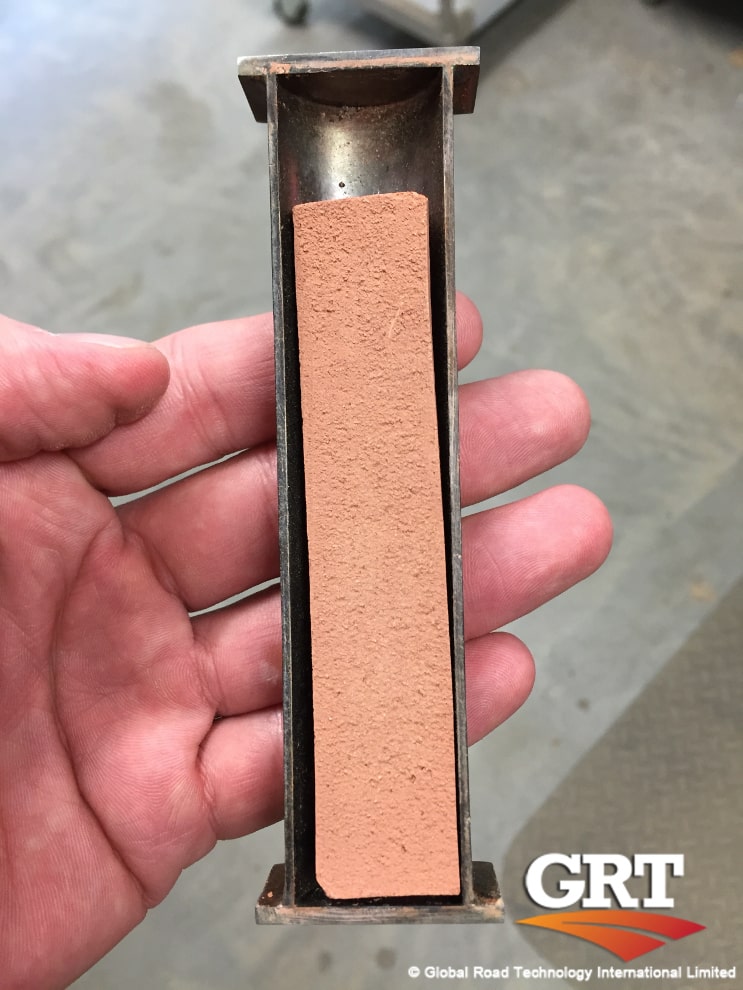
The material falls within the “high plasticity” range and is an example of natural soils that are problematic when present where road construction is to be carried out.
Without the availability of suitable replacement materials the only option is stabilization.
Stabilizing additives that can minimize cracking, can control or minimize the shrink swell potential and increase bearing capacity, can help reduce maintenance and increase the working life of the roads.
Water content drastically influences properties of fine-grained soils. Depending on the moisture content, clayey and silty soils may appear in four states: solid, semi-solid, plastic and liquid. As a hard, rigid solid in the dry state, fine grained soil becomes a crumbly (friable) semisolid when certain moisture content, or shrinkage limit, is reached. This soil will also begin to swell as shrinkage limit is exceeded. Increasing the water content beyond the soil’s plastic limit will transform it into a plastic mass, which causes additional swelling. The soil will remain in this plastic state until its liquid limit is exceeded, which causes it to transform into a viscous liquid that flows when jarred. These limits, shrinkage (SL), plastic (PL) and liquid limit (LL) are known under one name, Atterberg limits.
Depending on the type of fine-grained soil the Atterberg limits have different values. For example, shrinkage limit of illite is in range of 15% to 17% depending on particle sizes, its plastic limit is from 24% to 52%, while its liquid limit is from 30% to 110%; SL of kaolinite is from 25% to 29%, its PL is in range of 30% to 40%, while LL is from 35% to 72%, etc.
Common way to describe expansive soils is through plasticity index (PI) values. The plasticity index is the range of water contents values where the soil exhibits plastic properties; PI is the difference between liquid limit and plastic limit (PI = LL-PL). Clay loam has PI 10-20% and is referred as medium plastic soil. Silty clay has PI 20-35% and is considered highly plastic. Very high plasticity has soil which is predominantly clay and this kind of soil has PI higher than 35%.
The Atterberg limits of soils are very important in construction. Prior to construction works expansive soils have to be stabilized to provide adequate support for roads and buildings. There are many methods for stabilizing soil to gain required engineering specifications. These methods range from mechanical to chemical stabilization, but the most affective are chemical methods.
The addition of class C fly ash to highly plastic clay shows a reduction in shrinkage. Although fly ash is not as effective as lime, there are two reasons for its use: 1) fly ash is a highly generated waste containing environmentally harmful substances and thus it is preferred to be reused; 2) lime and cement are more expensive and fly ash is cheaper substitute. Although there are some environmental and economic benefits gained through use of fly ash, the new important problems arise; as fly ash contains harmful compounds and is water soluble, water runoff can easily transfer these substances from treated soil to nearby surface and underground water.
Lime stabilization has been used extensively in high plasticity soils. The addition of lime results in several stabilizing reactions. The solubility of silica increases in alkaline environment and silica becomes available as a cementing agent. The lime also provides a divalent cation which forms casilicates and Ca-Al hydrates that increase soil strength. However, if soil contains organics, sulphates, and some iron compounds, lime stabilization reactions can be inhibited.
Cement sets and hardens independently and can bind other materials together. It has high compressive strength. Cement reduces plasticity and the potential for volume change, as well as increases shear strength. It’s not effective for soils containing highly plastic clays. Furthermore, cement stabilization is costly and requires high degree of quality control. Because of changes in volume which happen due to cement hydration, early shrinkage cracks can occur in soil-cement layers.
Huge issue nowadays associated with use of lime and cement is their extremely high carbon footprint.
GRT7000 is environmentally friendly solution for stabilization of all soil types no matter of Atterberg limits values or content of organics, sulphates, etc. It is highly effective polymer-based soil binder. GRT7000 is needed in much lower concentrations than lime and cement. In the case of soils with plasticity index higher than 20 (which is characteristic of clayey soils), general recommendation is 3-5% of lime or 3-7% of cement, while GRT7000 is needed in concentration as low as 1%. Application of GRT7000 showed extraordinary results in treating soils with Atterberg limits indicating high plasticity:
For more information on Atterberg Limits or Global Road Technology contact please contact GRT.
Are environmental regulations, health and safety concerns or potential profit loss a concern right now?
Contact Us Now